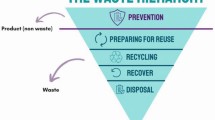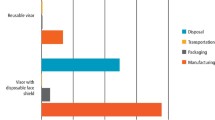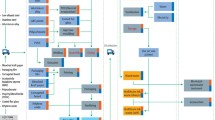Abstract
This chapter aims to describe the types of waste produced in dental practice, the costs associated with disposal of this waste, and the impact that the disposal method has on the environment and on human health. It discusses the waste hierarchy and explores how dental surgeries can reduce their waste generation through simple changes in practice. The chapter continues by highlighting the benefits of performing a waste audit, with examples of how correct segregation of the waste produced in practice is both cost-effective and reduces the environmental impact of its disposal. Finally, we discuss some of the barriers and enablers of changing waste disposal behaviours in the dental practice and identify how the environmentally minded practitioner can encourage pro-environmental behaviour in their dental team.
Key points
-
Highlights legal requirements, environmental and safety reasons to segregate waste appropriately.
-
Describes how incorrectly separated waste sent to landfill can be expensive and often contains items that should be allocated to recyclable waste.
-
Shows the environmental and human health impacts of processing 1,000 kg of various dental waste streams.
This is a preview of subscription content, access via your institution
Access options
Subscribe to this journal
Receive 24 print issues and online access
$259.00 per year
only $10.79 per issue
Buy this article
- Purchase on Springer Link
- Instant access to full article PDF
Prices may be subject to local taxes which are calculated during checkout

Similar content being viewed by others
References
UK Government. Hazardous waste. Available at https://www.gov.uk/dispose-hazardous-waste (accessed July 2021).
Centre for Sustainable Healthcare. Introducing recycling operating theatres. Available at https://map.sustainablehealthcare.org.uk/oxford-radcliffe-hospitals-nhs-trust/introducing-recycling-operating-theatres (accessed July 2021).
Green Healthcare. Reducing food waste in Irish hospitals: results, guidance and tips from a 3year programme. 2013. Available at https://www.lenus.ie/handle/10147/324073 (accessed November 2021).
United States Environmental Protection Agency. Overview of Greenhouse Gases. Available at https://www.epa.gov/ghgemissions/overview-greenhouse-gases (accessed July 2021).
Moulta J A, Allanc S R, Hewitta C N, Berners-Lee M. Greenhouse gas emissions of food waste. Available at https://eprints.lancs.ac.uk/id/eprint/124861/1/Moult_et_al_2018.pdf (accessed July 2021).
Duane B, Ramasubbu D, Harford S et al. Environmental sustainability and waste within the dental practice. Br Dent J 2019; 226: 611-618.
Jagtap S, Garcia-Garcia G, Duong L, Swainson M, Martindale W. Codesign of food system and circular economy approaches for the development of livestock feeds from insect larvae. Foods 2021; 10: 1701.
World Health Organisation. Homepage. Available at https://www.who.int/europe/home?v=welcome (accessed July 2021).
Gautam V, Thapar R, Sharma M. Biomedical waste management: incineration versus environmental safety. Indian J Med Microbiol 2010; 28: 191-192.
Nzihou A, Themelis N J, Kemiha M, Benhamou Y. Dioxin emissions from landfill solid waste incinerators (MSWIs) in France. Waste Manag 2012; 32: 2273-2277.
Viel J-F, Floret N, Deconinck E, Focant J-F, De Pauw E, Cahn J-Y. Increased risk of non-Hodgkin lymphoma and serum organochlorine concentrations among neighbors of a landfill solid waste incinerator. Environ Int 2011; 37: 449-453.
Fiordelisi A, Piscitelli P, Trimarco B, Coscioni E, Iaccarino G, Sorriento D. The mechanisms of air pollution and particulate matter in cardiovascular diseases. Heart Fail Rev 2017; 22: 337-347.
Tait P W, Brew J, Che A et al. The health impacts of waste incineration: a systematic review. Aust N Z J Public Health 2020; 44: 40-48.
International Association for Disability and Oral Health. Taking special care to manage our waste sustainably - an audit of the waste management practices in Ireland's National Coagulation Centre. Available at https://www.researchgate.net/publication/350963709_International_Association_for_Disability_Oral_Health_Research_Symposium_2020_RESEARCH_SYMPOSIUM_2020_Proceedings_Abstracts_2_International_Association_for_Disability_Oral_Health_Research_Symposium (accessed July 2021).
Richardson J, Grose J, Manzi S et al. What's in a bin: a case study of dental clinical waste composition and potential greenhouse gas emission savings. Br Dent J 2016; 220: 61-66.
Environmental Protection Agency: Greenhealthcare. Reducing Waste in Irish Healthcare Facilities. 2014. Available at https://www.epa.ie/publications/ (accessed July 2021).
Environmental Protection Agency: Greenhealthcare. Howto Guide: Undertaking a Bin Placement Survey. Available at https://www.greenhealthcare.ie/wp-content/uploads/2014/05/How-To-Undertake-a-Bin-Placement-Survey-revised.pdf (accessed July 2021).
Brunton P A, Sharif M O, Creanor S, Burke F J, Wilson N H. Contemporary dental practice in the UK in 2008: indirect restorations and fixed prosthodontics. Br Dent J 2012; 212: 115-119.
Barnosky E, Delmas M A, Huysentruyt M. The circular economy: motivating recycling behaviour for a more effective system. 2019. DOI: 10.2139/ssrn.3466359.
Duane B, Dixon J, Ambibola G et al. Embedding environmental sustainability within the modern dental curriculum - Exploring current practice and developing a shared understanding. Eur J Dent Educ 2021; 25: 541-549.
NHS England. E-learning for Healthcare. Available at https://www.e-lfh.org.uk/e-den/ (accessed July 2021).
Academy of Medical Royal Colleges. Protecting Resources, Promoting Value: a doctor's guide to cutting waste in clinical care. 2014. Available at https://www.aomrc.org.uk/wp-content/uploads/2016/05/Protecting_Resources_Promoting_Value_1114.pdf (accessed August 2023).
Derksen L, Gartrell J. The Social Context of Recycling. Am Sociol Rev 1993; 58: 434-442.
Grose J, Burns L, Mukonoweshuro R et al. Developing sustainability in a dental practice through an action research approach. Br Dent J 2018; 225: 409-413.
Royal College of Physicians. Less waste, more health: A health professional's guide to reducing waste. 2018. Available at https://www.rcplondon.ac.uk/projects/outputs/less-waste-more-health-health-professionals-guide-reducing-waste (accessed July 2021).
Pietzsch N, Ribeiro J L, de Medeiros J F. Benefits, challenges and critical factors of success for Zero Waste: a systematic literature review. Waste Manag 2017; 67: 324-353.
UK Government. The Environmental Permitting (England and Wales) Regulations 2007. Available at https://www.legislation.gov.uk/uksi/2007/3538/contents/made (accessed November 2018).
European Commission. Waste and Recycling. Available at https://environment.ec.europa.eu/topics/waste-and-recycling/waste-framework-directive_en (accessed July 2021).
UK Government. The Waste (Scotland) Regulations 2012. Available at https://www.legislation.gov.uk/sdsi/2012/9780111016657/contents (accessed November 2018).
Grilli G, Curtis J. Encouraging pro-environmental behaviours: a review of methods and approaches. Renew Sust Energ Rev 2021; 135: 110039.
Cobern M K, Porter B E, Leeming F C, Dwyer W O. The effect of commitment on adoption and diffusion of grass cycling. Environ Behav 1995; 27: 213-232
Cosic A, Cosic H, Ille S. Can nudges affect students' green behaviour? A field experiment. J Behav Econ Policy 2018; 2: 107-111.
Maki A, Burns R, Ha L, Rothman A. Corrigendum to "Paying people to protect the environment: a meta-analysis of financial incentive interventions to promote proenvironmental behaviors". J Environ Psychol 2016; 47: 242-255.
Acknowledgements
The BDJ Editorial Team would like to thank the authors of this chapter for granting us permission to republish their chapter within our journal. This chapter was first originally published in B. Duane (ed), Sustainable Dentistry, BDJ Clinician's Guides, https://doi.org/10.1007/978-3-031-07999-3_10 © The Author(s), under exclusive licence to Springer Nature Switzerland AG 2022.
Author information
Authors and Affiliations
Corresponding author
Rights and permissions
About this article
Cite this article
Wilmott, S., Pasdeki-Clewer, E. & Duane, B. Responsible waste management: using resources efficiently (Part 2). Br Dent J 235, 577–582 (2023). https://doi.org/10.1038/s41415-023-6322-7
Published:
Issue Date:
DOI: https://doi.org/10.1038/s41415-023-6322-7



